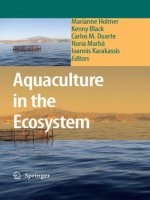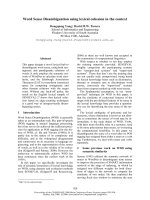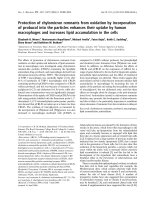FOOTPRINTS IN THE JUNGLE ppt
Bạn đang xem bản rút gọn của tài liệu. Xem và tải ngay bản đầy đủ của tài liệu tại đây (18.38 MB, 353 trang )
FOOTPRINTS
IN THE
JUNGLE
This page intentionally left blank
FOOTPRINTS
IN THE
JUNGLE
Natural Resource Industries,
Infrastructure,
and
Biodiversity Conservation
EDITED
BY
Ian A.
Bowles
Glenn
T.
Prickett
ASSISTANT
EDITOR
Amy
E.
Skoczlas
OXFORD
UNIVERSITY
PRESS
2001
OXFORD
UNIVERSITY
PRESS
Oxford
New
York
Athens Auckland Bangkok Bogota Buenos Aires Calcutta
Cape
Town Chennai
Dar es
Salaam Delhi Florence Hong
Kong
Istanbul
Karachi
Kuala Lumpur Madrid Melbourne Mexico City Mumbai
Nairobi
Paris
Sao
Paulo Shanghai Singapore Taipei Tokyo Toronto Warsaw
and
associated companies
in
Berlin
Ibadan
Copyright
©
2001
by
Oxford University Press, Inc.
Published
by
Oxford
University Press, Inc.
198
Madison Avenue,
New
York,
New
York
10016
Oxford
is a
registered trademark
of
Oxford
University Press.
All
rights reserved.
No
part
of
this publication
may be
reproduced,
stored
in a
retrieval system,
or
transmitted,
in any
form
or by any
means,
electronic, mechanical, photocopying, recording,
or
otherwise,
without
the
prior permission
of
Oxford
University
Press.
Library
of
Congress Cataloging-in-Publication
Data
Footprints
in the
jungle
:
natural resource
industries,
infrastructure,
and
biodiversity conservation
/
edited
by
Ian A.
Bowles, Glenn
T.
Prickett;
editorial assistance
by Amy E.
Skoczlas.
p.
cm.
Includes bibliographical references
and
index.
ISBN
0-19-512578-9
1.
Forest management—Tropics.
2.
Forest products industry—
Environmental aspects—Tropics.
3.
Economic development—
Environmental aspects—Tropics.
4.
Biological diversity
conservation—Tropics.
5.
Rain
forest
conservation.
6.
Rain
forest
ecology.
I.
Bowles,
Ian A. II.
Prickett, Glenn
T.
SD247.F66
2000
333.95'16'0913—dc21 99-18433
The
views
in
this
volume
are not
intended
to
reflect
the
views
of the
Council
on
Environmental Equality,
the
National Security Council,
or the
U.S. government.
987654321
Printed
in the
United States
of
America
on
recycled, acid-free paper
Preface
A
sharp increase
in
investment
by
resource industries
is
changing
the
course
of
history
for
delicate tropical ecosystems
and the
communi-
ties
who
inhabit
them. This volume
is
intended
to
help
all
concerned
parties—activists, corporations, local communities, governments,
and
conservation organizations—address
this
growing challenge.
In
the
pages
that
follow,
contributors examine
the
environmental
and
social impacts
of
resource extraction
and
infrastructure develop-
ment
and
highlight approaches taken
to
date
to
address these issues
by
both companies
and
nongovernmental organizations
(NGOs).
The
book
is
intended
to
stimulate
debate about
the
feasibility
of, and
con-
straints
to,
developing natural resources
in a
manner that
safeguards
biodiversity
and
respects
the
interests
of
local communities.
It
seeks
to
highlight emerging "best practices"
and
focus
attention
on
chal-
lenging technical, environmental, social,
and
legal
issues.
The
book
is
organized into
five
parts. Part
I
provides
the
reader
with
an
overview
of the
book's main topics
and
themes.
In the
open-
ing
essay, conservationists Russell Mittermeier
and
William Konstant
explain
why we
should care about biodiversity
in the
first
place. They
explain that scientists
and the
general public understand very little
about
"biodiversity"—the term used
to
encompass
the
wide range
of
species, ecosystems,
and
ecological processes that
are
found
on the
planet Earth.
The
authors
discuss
challenges
to
conserving
this
biodi-
versity
and
approaches
to
setting priorities
for
conservation invest-
ments.
Chapter
2
helps
set the
stage
for
future
chapters
by
examining
new
trends
in
development
finance.
Everett Santos,
of
Emerging Market
Partners, formerly
a
senior
official
at the
World Bank's private sector
arm,
the
International Finance Corporation, describes infrastructure
financing
as an
example
of the
rapid growth
in
private sector invest-
ment
in
developing countries
and the
emerging
shift
from
public
to
private finance.
Chapter
3
provides
a
different
perspective
on the
role
of
extractive
industries
in
environmental protection
and
economic development.
Chris
Chamberlain
and
Lisa Jordan
of the
Bank
Information
Center,
an NGO
that promotes
reform
and
transparency
at the
multilateral
development banks, summarize
the
range
of
approaches undertaken
by
environmental organizations
to
bring about greater
public
account-
ability
in
both leading corporations
and
public institutions.
Parts
II
through
V
address
the
specific sectors
of oil and
gas, timber,
mining,
and
infrastructure. Each part begins with
an
overview
of the
key
environmental
and
social challenges
in the
sector
and a
summary
of
emerging best practices. Case studies
on a
wide range
of
operations
throughout
the
tropics highlight
key
issues
in
depth, including
the
following:
technologies
and
practices
for
environmental management;
creation
of new
protected areas
in the
context
of
resource develop-
ment; managing impacts
on
local communities
and
supporting com-
munity development; independent monitoring
and
evaluation
of en-
vironmental
and
social impacts; product certification
and
consumer
awareness;
and
legal mechanisms
to
provide
for
benefit-sharing
among
national governments
and
local communities.
Part
II
concerns
oil and gas
development. Chapter
4, an
overview
by
Amy
Rosenfeld
and her
colleagues
at
Conservation International,
describes investment trends, potential impacts,
and
emerging best
practices
for
petroleum development
in the
tropics.
In
chapter
5,
Jen-
nifer
Parnell
and
Robert
Kratsas, environmental experts with
the At-
lantic
Richfield
Corporation,
now
merged
with
BP,
provide their
in-
dustry perspective
on the
same challenges, using case studies
to
illustrate
their
points. Chapter
6, by
authors
from
Conservation Inter-
national
and
Mobil, presents their
experience
in
ecological monitor-
ing in the
exploration stage
of oil
development
in the
Peruvian Ama-
zon—the
site
of a
recent surge
in
petroleum extraction activity.
Part
III
addresses
the
onslaught
of
timber development
in
tropical
forests,
painting
a
challenging picture
for
conservationists because,
unlike oil, gas,
and
mineral development, logging
has a
much larger
"footprint"
and can
have
far
more extensive impacts
on
biodiversity.
Chapter
7, an
overview
by
Nigel Sizer,
who
leads
the
World
Re-
sources
Institute's
Forest Frontiers Initiative, summarizes
the
current
state
of the
world's tropical
forests
and
documents numerous exam-
ples
of how
Pacific
Rim
nations
in
particular
are
driving
the
expan-
sion
of
logging into
the
world's remaining tropical
frontiers. In
chap-
ter 8,
Erling Lorentzen,
a
leading Brazilian
industrialist
and
chairman
of
Aracruz Celulose, presents
the
case
for
plantations' ability
to
meet
vi
Preface
global
wood demand.
The
case study
of
Aracruz describes
how
plan-
tations
can be
sited
on
degraded lands
and be
operated
in a
profitable
and
environmentally sensitive manner.
In
chapter
9
Justin Ward
of
Conservation International
and
Yurij
Bihun
of the
Natural Resources
Defense
Council
and
Shelterwood
Systems International, respectively, present
one
response
to the
expansion
of
logging
into
tropical
forest
frontiers:
the use of
"timber
certification"
and
community
forest
management techniques
in the
tropical
forests
of
southern Mexico.
Finally, Part
III
concludes with
a
thought-provoking chapter
by
nat-
ural resource economists Richard
Rice
and
Cheri Sugal,
and
biologists
Peter
Frumhoff,
Liz
Losos,
and Ted
Gullison
on
strategies
for
achiev-
ing
conservation results
in the
context
of
tropical
forests
being subject
to
logging.
The
authors provide
a
powerful
counterpoint
to
those
who
are
advocating "sustainable management"
of
timber resources
in the
tropics
by
pointing
out
that there
are
often
more direct ways
to
con-
serve biodiversity
in the
context
of
logging—such
as use of
primary
forest
"set-asides"—than through investments
in
silvicultural "best
practices."
Part
IV
addresses mineral development
in the
tropics.
In
chapter
11,
professor Alyson Warhurst
and her
colleague Kevin Franklin
at
the
Warwick Business School
at the
University
of
Warwick, England,
provide
an
overview
of
recent trends
and
emerging technological
im-
provements
in
mineral development.
In
chapter
12,
Gary
Nash
of the
International Council
on
Metals
and the
Environment
(ICME),
a
con-
sortium
of
major
nonferrous mining companies, provides
an
industry
perspective
on the
same issues. Nash provides
an
interesting sum-
mary
of the use of
voluntary guidelines
and
describes
ICME's
efforts
to
educate
its
members through
a
variety
of
case studies.
In
chapter
13,
Fred Graybeal
of
Asarco,
one of the
largest base metal
mining companies
in the
world, summarizes
his
company's experi-
ence
with
best practices
for
mining
in
tropical
forests;
he
highlights
Asarco's experience with
the
creation
of an
independent Environ-
mental Advisory Committee
for a
gold mining
project
in
northern
French
Guiana—a
case study that
frankly
discusses
the
costs
and
ben-
efits
of
this
approach. Chapter
14, by
David Smith,
Vice
Dean
of
Har-
vard
Law
School,
and
Cyril
Kormos,
of
Conservation International,
provides
an
historical perspective
on the use of
legislation
and
con-
tracts
to
safeguard
the
environment
in the
context
of
mineral
and pe-
troleum
projects
in
developing countries. They conclude that, while
the
time-consuming
and
costly process
of
developing
effective
legisla-
tion
and
regulatory capacity unfolds, contracts, insurance,
and
other
legal
protections
can and
should
be
built directly into
the
agreements
that govern individual
projects.
Part
V
addresses
the
common thread
in
major
natural resource
ex-
traction
projects:
the
infrastructure that ties them
to
markets
and
Preface
vii
sources
of
labor, goods,
and
services.
In
chapter
15, an
overview
on
infrastructure
and
challenges
for
conservation, leading Brazilian
in-
dustrialist
and
former
Minister
of
Strategic
Affairs
Eliezer Batista
and
his
colleagues provide
a
primer
on how
development planners
can
evaluate
major
infrastructure projects
to
reduce their ultimate impact
on
biodiversity.
In
doing
so,
this
chapter
considers
the
conservation
implications both
of
major
"integration"
and
"penetration"
projects.
Chapter
16, by
Robert Dobias
of the
Asian Development Bank
and
Kirk
Talbott
of
Conservation International, considers
the
specific
in-
frastructure
"integration" case
in the
highly populated greater
Me-
kong
subregion
in
southeast Asia. Dobias
and
Talbott consider
the
role
of
government
and of
public participation
in the
many processes
that underpin large-scale infrastructure
projects.
In
chapter
17,
John Reid
of the
Conservation Strategy Fund
goes
to
the
other
end of the
spectrum
and
considers
the
conservation implica-
tions
of new
rural roads
in
more remote areas.
In
presenting case
studies
from
both
the
remote Bolivian Amazon
and a
less
developed
part
of the
Brazilian Atlantic coastal
forest,
Reid summarizes
the
chal-
lenges
presented
by
individual road projects
and
explains
how
con-
servationists
can
deploy economic cost-benefit analyses
to
strengthen
environmental arguments. Reid also presents
the
concrete case
of
how a new
park,
or
conservation
"offset,"
was
created
in
southern
Bahia
to
reduce
the
impact
of
road development
on
biodiversity. Part
V
concludes
with
an
interesting description
of a
joint
project
of the
Andean Development Corporation
and
Conservation International,
an
innovative
new
software tool, Condor, which
is
currently being used
by
infrastructure
planners
to
help
avoid impacts
on
biodiversity.
We
introduce
and
conclude
the
volume
with
a
broad analysis
of
trends
in
natural
resource
industries
and
related infrastructure
and a
set of
recommendations
for all
those concerned with their footprints
in the
jungle.
Ian A.
Bowles
Glenn
T.
Prickett
viii
Preface
Acknowledgments
This book
is the
product
of a
great many contributors. First
and
fore-
most,
the
editors
are
grateful
to Ms. Amy
Skoczlas
for her
tireless
devotion
and
leadership
as our
Assistant Editor.
The
editors would
also like
to
thank
the
outstanding group
of
contributing authors
who
provided excellent chapters that
are the
main subject
of the
book—
the
authors gave liberally
of
their time
and
shared with
us and the
readers their enthusiasm
and
experience with complex issues.
In ad-
dition,
the
editors would like
to
thank Robin
Bell
and
Debra
Gordon
for
their critical support
in
development
of the
book prospectus
and
our
initial
discussions with
Oxford
University Press.
We
would also
like
to
thank many Conservation International
staff
including
Lena
McDowall,
Sterling Zumbrunn, Tanya Tarar, Petra MacGowan,
Amy
Rosenfeld,
Cheri Sugal,
Jeff
Mastracchio,
and
Aaron Bruner
for
their
help. Finally,
we
would like
to
thank
our
editor,
Joyce
Berry
at Ox-
ford
University Press,
for her
enthusiasm, encouragement,
and
flexi-
bility throughout
the
process that
has led to
publication
of
this
vol-
ume.
Ian
thanks
his
family
for
their encouragement
and
dedicates
this
effort
to the
memory
of his
grandfather,
Dr.
George
H. A.
Clowes Jr.,
for
his
scholarly leadership
and
great love
of
nature. Glenn would like
to
thank
his
wife,
Lisa
Prickett,
for her
support
and
encouragement
of
this
effort,
and his
father,
Gordon Prickett,
for his
valuable insights
as
both
a
mining engineer
and
environmentalist.
This page intentionally left blank
Contents
About
the
Editors
xv
Contributors xvii
Introduction.
The
Growing Footprint: Resource Extraction
Investments Expand Further into
the
Humid Tropics
3
Ian
A.
Bowles
Glenn
T.
Prickett
Part
I:
Conservation
and
Development
in the
Twenty-first-Century
Tropics
1
Biodiversity Conservation: Global Priorities, Trends,
and the
Outlook
for the
Future
9
Russell
A.
Mittermeier
William
R.
Konstant
2
Private-Sector Participation
in
Infrastructure Development
29
Everett
J.
Santos
3
Partner
or
Pariah: Public Perceptions
and
Responses
to
the
Extractive Industries
37
Lisa
Jordan
Christopher
H.
Chamberlain
Partll:
Oil and Gas
Development Meet Conservation
4
Reinventing
the
Well: Approaches
to
Minimizing
the
Environmental
and
Social Impact
of Oil
Development
in the
Tropics
55
Amy B.
Rosenfeld
Debra
Gordon
Marianne
Guerin-McManus
5
An
Industry Perspective
on
Environmental
and
Social Issues
in Oil and Gas
Development: Case Studies
from
Indonesia
and
Ecuador
73
Robert
Kratsas
Jennifer
A.
Pamell
6
Monitoring Impacts
of
Hydrocarbon Exploration
in
Sensitive
Terrestrial Ecosystems: Perspectives
from
Block
78,
Peru
90
Jorgen
B.
Thomsen
Carol
Mitchell
Richard
Piland
Joseph
R.
Donnaway
Part
III:
Forests under Pressure
7
Trade, Transnationals,
and
Tropical Deforestation
115
Nigel
Sizer
8
Aracruz Celulose:
A
Case History
134
Erling
Lorentzen
9
Stewardship
of
Mexico's Community Forests: Expanding
Market
and
Policy Opportunities
for
Conservation
and
Rural
Development
145
Justin
R.
Ward
Yurij
Bihun
10
Options
for
Conserving Biodiversity
in the
Context
of
Logging
in
Tropical Forests
168
Richard Rice
Cheri
Sugal
Peter
C.
Frumhoff
Elizabeth Losos
Raymond Gullison
xii
Contents
Part
IV:
Mining
and
Conservation
11
Biodiversity Conservation, Minerals Extraction,
and
Development: Toward
a
Realistic Partnership
183
Alyson Warhurst
Kevin
Franklin
12
Mining Industry Responses
to
Environmental
and
Social
Issues
204
Gary
Nash
13
Evolution
of
Environmental Practice during Exploration
at the
Camp Caiman Gold Project
in
French Guiana
222
Frederick
T.
Graybeal
14
Conservation
and
Concession Contracts: Environmental Issues
in
Mineral Extraction Agreements
233
David
N.
Smith
Cyril
Kormos
Part
V:
Infrastructure
for
Sustainable Development
15
Rethinking Infrastructure: Approaches
to
Managing
Development
on the
National
and
Continental Scale
to
Reduce
Conservation Impacts
249
Eliezer
Batista
da
Silva
Gustavo
A.B.
da
Fonseca
Amy B.
Rosenfeld
16
Environmental
and
Social Considerations
in the
Development
of
the
Greater Mekong Subregion's Road Network
258
Robert
J.
Dobias
Kirk
Talbott
17
Roads
and
Tropical Forests: From White Lines
to
White Elephants
281
John
Reid
18
Condor: Better Decisionmaking
on
Infrastructure Projects
292
Silvio Olivieri
Claudia
Martinez
Contents
xiii
Part
VI:
Conclusion
Conclusion. Leave More Than Footprints:
The New
Corporate
Responsibility
307
Glenn
T.
Prickett
Ian
A,
Bowles
Index
317
xiv
Contents
About
the
Editors
Until Spring 1999,
Ian A.
Bowles
was
Vice President
of
Conservation
Policy
at
Conservation International
(CI);
he
directed CI's work
in the
areas
of
policy research, natural resource economics,
finance,
and
law.
He is the
author
of
more
than
twenty
published
articles
on
con-
servation issues;
his
research
at CI
focused
on the
role
of
development
agencies
and the
private sector
in
biodiversity conservation. Bowles
now
serves
as
Associate Director
for
International
Affairs
at the
Coun-
cil on
Environmental Quality
and as
Director
of
Environmental
Af-
fairs
at the
National Security Council
in the
White House. This book
was
written prior
to his
government service
and no
views expressed
in the
book represent
a
position
of the
Executive
Office
of the
Presi-
dent
or the
United States government.
He is a
graduate
of
Harvard
University
and is a
native
of
Woods Hole, Massachusetts, where
he is
also active
on
local environmental
issues.
Glenn
T.
Prickett
is
Vice
President
for
Business
and
Policy
at CI;
he
leads strategic partnerships between
CI and
major
international
corporations
in a
range
of
fields,
including
oil and gas
development,
mining,
and
infrastructure development, among others. Prior
to
join-
ing CI,
Prickett served
as
Chief Environmental Advisor
at the
U.S.
Agency
for
International Development.
He is a
graduate
of
Yale Uni-
versity
and
resides
in
Great Falls, Virginia, with
his
wife,
Lisa.
Working
in
twenty-three countries around
the
world,
CI is a
field-
based, nonprofit organization that protects
the
Earth's biologically
richest ecosystems
and
helps
the
people
who
live there improve
their
xv
quality
of
life.
CI
seeks
to
harness
the
power
of the
private sector
to
deliver conservation solutions
in the
world's most important natural
ecosystems. CI's mission
is to
conserve
the
Earth's living heritage
and
global
biodiversity
and to
demonstrate that human societies
are
able
to
live harmoniously
with
nature.
xvi
About
the
Editors
Contributors
Eliezer
Batista
is the
Chairman
of Rio
Doce International S.A.
in Rio
de
Janeiro.
Yurij
Bihun
is a
consulting forester
and
Director
of
Shelterwood Sys-
tems International
in
Burlington, Vermont.
Ian A.
Bowles
was
Vice President
of
Conservation Policy
at
Conserva-
tion International
in
Washington, D.C.,
at the
time
he
edited this
book.
Christopher
H.
Chamberlain
is the
Project
Manager
for
Central/East-
ern
Europe
at the
Bank Information Center
in
Washington, B.C.
At
the
time
of
writing, Robert
J.
Dobias
was the
Senior Environmental
Specialist
in the
Office
of
Environment
and
Social Development
at
the
Asian Development Bank
in
Manila.
Joseph
Donnaway
is
Manager
of
Health
and
Safety
for
Mobil Corpora-
tion
in
Dallas, Texas.
Gustavo
A.B.
da
Fonseca
is
Vice President
and
Executive Director
of
the
Center
for
Applied Biodiversity Science
at
Conservation Interna-
tional.
Kevin
Franklin
is
Research
Officer
researching biodiversity conserva-
tion indicators
and
minerals development
at the
Mining
and
Energy
Research Network, Warwick Business School, University
of
Warwick,
England.
Peter
C.
Frumhoff
is
Director
of the
Department
of
Global Resources
at the
Union
of
Concerned Scientists
in
Cambridge, Massachusetts.
XVII
Debra
Gordon
was
formerly Coordinator
for
Conservation Policy
at
Conservation International
in
Washington,
D.C.
At the
time
of
writing, Frederick
T.
Graybeal
was
Chief Geologist
of
Asarco Incorporated
in New
York City.
Marianne Guerin-McManus
is
Director
of
Conservation Finance
at
Conservation International
in
Washington, D.C.
Raymond
Gullison
is a
Research Associate
at the
University
of
British
Columbia
in
Vancouver.
Lisa
Jordan
is
Executive Director
of the
Bank Information Center
in
Washington,
D.C.
William
R.
Konstant
is
Special Projects Director
for
Conservation
In-
ternational
in
Washington,
D.C.
Cyril Kormos
is Director of
Conservation Policy
at
Conservation Inter-
national
in
Washington,
D.C.
Robert Kratsas
was
Manager
of the
Environment, Health,
and
Safety
Department
of
ARCO
International
Oil and Gas
Company
in
Piano,
Texas.
Erling Lorentzen
is
Chairman
of
Aracruz Celulose
in
Minas Gerais,
Brazil.
Elizabeth
Losos
is Director of the
Center
for
Tropical Forest Science
at
the
Smithsonian Tropical Research Institute
in
Washington,
D.C.
Claudia Martinez
is
Head
of
Coordination
for
Sustainable Develop-
ment
at
Corporacion
Andina
de
Fomento
in
Caracas,
Venezuela.
Carol
Mitchell
is
EISA
Environmental Coordinator
for
Conservation
International
in
Lima, Peru.
Russell
A.
Mittermeier
is
President
of
Conservation International
in
Washington,
D.C.
Gary
Nash
is
Secretary General
of the
International Council
on
Metals
and the
Environment
in
Ottawa, Canada.
Silvio
Olivieri
is
Vice President
for
Strategic Planning
at
Conserva-
tion International
in
Washington,
D.C.
At
the
time
of
writing, Jennifer
A.
Parnell
was
Senior Environmental
Engineer
in the
Environment, Health,
and
Safety Department
of
ARCO
International
Oil and Gas
Company
in
Piano, Texas.
Richard
Piland
was Director of
Projects
for
Conservation International
in
Lima, Peru,
at the
time
he
contributed
to
this
book.
Glenn
T.
Prickett
is
Vice President
for
Business
and
Policy
at
Conser-
vation International
in
Washington,
D.C.
xviii
Contributors
John
Reid
is
President
of the
Conservation Strategy Fund
of the Pa-
cific
Forest Trust
in
Boonville, California.
Richard Rice
is
Chief Economist
in the
Center
for
Applied Biodiver-
sity Science
at
Conservation International
in
Washington, D.C.
Amy B.
Rosenfeld
is
Director
of
Energy
and
Mining Industry Initia-
tives
at
Conservation International
in
Washington, D.C.
Everett
J.
Santos
is
Chief Executive
Officer
of the
Latin America
Group
of
Emerging Markets Corporation
in
Washington, D.C.
Nigel
Sizer
is
Team Leader
and
Senior Associate
of the
Latin America
Group
at the
World Resources Institute
in
Washington, D.C.
David
N.
Smith
is the
Vice Dean
of
Harvard
Law
School
in
Cam-
bridge, Massachusetts.
Cheri Sugal
is
Manager
of
Carbon
Offsets
and the
Tropical Wilderness
Protection
Fund
at
Conservation International
in
Washington, D.C.
Kirk
Talbott
is
Senior Director
for the
Asia
and
Pacific Region
at
Con-
servation International
in
Washington, D.C.
Jorgen
B.
Thomsen
is
Vice President
for
Monitoring
and
Evaluation,
and
Development Agency Relations
at
Conservation International
in
Washington, D.C.
Justin R.Ward
is
Director
of
Agriculture
and
Fisheries Industry Initia-
tives
at
Conservation International
in
Washington, D.C.
Alyson Warhurst
is
Director
of the
Mining
and
Energy Research Net-
work, Warwick Business School, University
of
Warwick, England.
Contributors
xix
This page intentionally left blank
FOOTPRINTS
IN THE
JUNGLE
This page intentionally left blank
Introduction
The
Growing Footprint: Resource
Extraction
Investments
Expand
Further
into
the
Humid Tropics
Ian A.
Bowles
Glenn
T.
Prickett
Extractive
industries
(logging,
mining,
oil and gas
development)
and
the
infrastructure associated with them (roads, pipelines, transmis-
sion lines) have
had
significant environmental impacts worldwide.
Today
the
potential impact
of
these industries
on
global biological
diversity
is
growing,
as
they
focus
increasingly
on new
opportunities
in
resource-rich developing countries, including some
of the
world's
most sensitive
and
poorly understood natural ecosystems.
In the
next
decade,
for
example,
it is
expected
that
a
significant
portion
of all
new oil
exploration
and
production will occur
in the
humid tropics.
The
discovery
of new
reserves
and the
liberalization
of
developing
country economies
are
pressing development
further
into
the
last
un-
disturbed tropical ecosystems—home
to the
world's greatest biodiver-
sity
and the
least contacted indigenous cultures.
Tropical Latin America
is a
case
in
point. Areas like
the
Amazon
regions
of
Peru
and
Colombia,
as
well
as
northern Guatemala, were,
until
recently, unattractive
for
major
petroleum development
due to
political
and
economic instability.
In
recent years, however, much
has
changed.
For
example, Colombia
is now
host
to the
largest
oil
discovery
in the
Western Hemisphere
in
twenty years. Peru
is
host
to
a
similarly large natural
gas
discovery
at the
Camisea
field.
And in
Guatemala,
oil
development
in the
Peten
region—largely
in
areas
that
overlap
the
ecologically sensitive Maya Biosphere Reserve—has
re-
turned
after
years
of
being largely stalled.
The
same trends hold true
for
mineral development. Between 1991
and
1996, investment
in
mineral exploration
in
Latin
America more than doubled,
from
$300
to
$700
million.
Indeed,
a
1996 survey
of
mining company executives
3
indicated that seven
of the top ten
countries that were believed
to
have
the
best opportunities
for
investment were
in
Latin America.
The
region
has
also seen
a
rapid increase
in
logging investments—
timber exports
from
Latin America jumped
120
percent
in the
period
from
1990
to
1996.
As
the
number
of
resource concessions
and
associated
infrastruc-
ture
projects
in
tropical countries rises, public concerns about their
environmental and social impacts increase as well. Recent experi-
ences
in
Nigeria, Indonesia, Colombia, Papua
New
Guinea,
Ecuador,
and
other countries highlight
a
growing trend
of
controversy around
resource
extraction operations. Because developing countries depend
on
revenue
from
resource extraction, however,
it is
clear that develop-
ment
of the
world's tropical ecosystems will continue
in
spite
of the
controversies.
Choices made
now
will
determine
the
"footprint"
of
these indus-
tries—the
extent
of
disturbance
to
natural habitats
and the
impacts
on
local communities.
The
question
for all
those concerned
with
the
conservation
of
global biodiversity
is how
best
to
respond
to
this
new
challenge.
We
believe that
a
number
of
important lessons
can be de-
rived
from
the
experiences summarized
in
this
book.
First,
resource companies
can
take
steps
to
dramatically reduce
their
impacts
on
ecosystems
and
communities seen
in
earlier
projects.
The
case studies
in
this
book describe emerging "best practices"
for
minimizing
direct
disturbance
of
habitats, preventing illegal coloniza-
tion that leads
to
further
destruction,
and
responding
to the
interests
of
local communities.
Due to the
weakness
of
regulatory regimes
in
many
developing countries, adoption
of
these practices
will
often
de-
pend
on a
company's voluntary
willingness
to
pursue them. There-
fore,
the
policies
and
motivations
of
individual companies—and
the
vigilance
of
local environmental
and
community advocates—will
be
key
determinants
of a
particular project's environmental
and
social
"footprint."
But
the
evidence
in
this
book also suggests that biodiversity
will
not be
conserved
by the use of
better management practices alone.
While
information
and
improved global communications mean that
companies
are
more readily accountable
for
their actions
in
remote
locales,
the use of
better practices
and
technologies
in
each footprint
can
only
do so
much.
In the
end, biodiversity will
be
largely con-
served
in the
natural,
pristine
areas that
are not
subject
to
intensive
resource development. This means that conservationists, corpora-
tions, local communities,
and
governments must include investments
in
conserving natural areas
as
part
of the
matrix used
to
judge
the
environmental performance
of
given projects. Proactive investment
in
biodiversity conservation should
be
considered part
of the
"cost
of
Introduction
4









